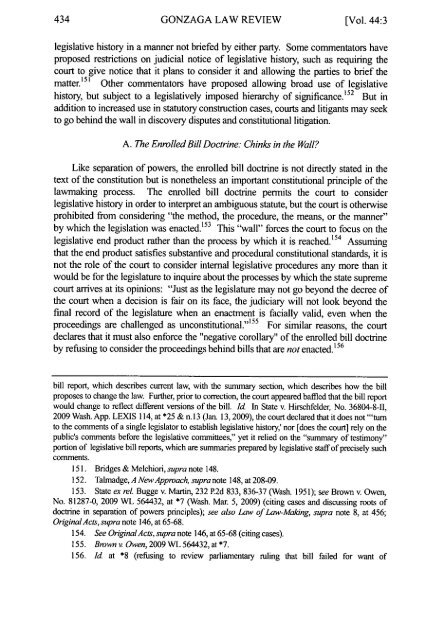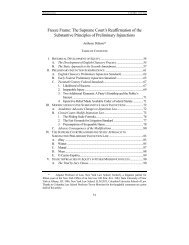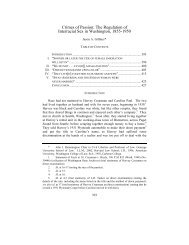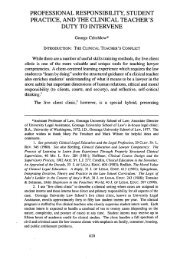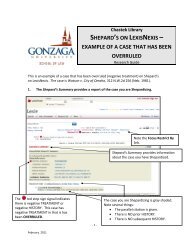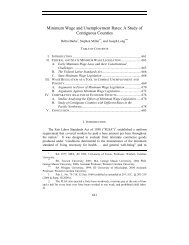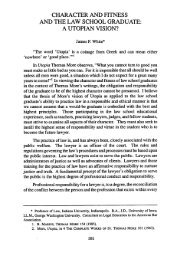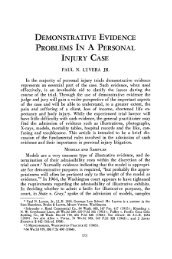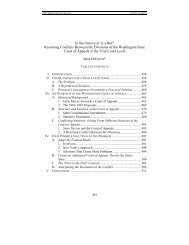I Developments in Washington's Law of Law-Making - Gonzaga ...
I Developments in Washington's Law of Law-Making - Gonzaga ...
I Developments in Washington's Law of Law-Making - Gonzaga ...
You also want an ePaper? Increase the reach of your titles
YUMPU automatically turns print PDFs into web optimized ePapers that Google loves.
GONZAGA LAW REVIEW<br />
[Vol. 44:3<br />
legislative history <strong>in</strong> a manner not briefed by either party. Some commentators have<br />
proposed restrictions on judicial notice <strong>of</strong> legislative history, such as requir<strong>in</strong>g the<br />
court to give notice that it plans to consider it and allow<strong>in</strong>g the parties to brief the<br />
matter. 15 ' Other commentators have proposed allow<strong>in</strong>g broad use <strong>of</strong> legislative<br />
history, but subject to a legislatively imposed hierarchy <strong>of</strong> significance., 5 2 But <strong>in</strong><br />
addition to <strong>in</strong>creased use <strong>in</strong> statutory construction cases, courts and litigants may seek<br />
to go beh<strong>in</strong>d the wall <strong>in</strong> discovery disputes and constitutional litigation.<br />
A. The Enrolled Bill Doctr<strong>in</strong>e: Ch<strong>in</strong>ks <strong>in</strong> the Wall?<br />
Like separation <strong>of</strong> powers, the enrolled bill doctr<strong>in</strong>e is not directly stated <strong>in</strong> the<br />
text <strong>of</strong> the constitution but is nonetheless an important constitutional pr<strong>in</strong>ciple <strong>of</strong> the<br />
lawmak<strong>in</strong>g process. The enrolled bill doctr<strong>in</strong>e permits the court to consider<br />
legislative history <strong>in</strong> order to <strong>in</strong>terpret an ambiguous statute, but the court is otherwise<br />
prohibited from consider<strong>in</strong>g "the method, the procedure, the means, or the manner"<br />
by which the legislation was enacted. 153 This "wall" forces the court to focus on the<br />
legislative end product rather than the process by which it is reached. 154 Assum<strong>in</strong>g<br />
that the end product satisfies substantive and procedural constitutional standards, it is<br />
not the role <strong>of</strong> the court to consider <strong>in</strong>ternal legislative procedures any more than it<br />
would be for the legislature to <strong>in</strong>quire about the processes by which the state supreme<br />
court arrives at its op<strong>in</strong>ions: "Just as the legislature may not go beyond the decree <strong>of</strong><br />
the court when a decision is fair on its face, the judiciary will not look beyond the<br />
f<strong>in</strong>al record <strong>of</strong> the legislature when an enactment is facially valid, even when the<br />
proceed<strong>in</strong>gs are challenged as unconstitutional."' 155 For similar reasons, the court<br />
declares that it must also enforce the "negative corollary" <strong>of</strong> the enrolled bill doctr<strong>in</strong>e<br />
by refus<strong>in</strong>g to consider the proceed<strong>in</strong>gs beh<strong>in</strong>d bills that are not enacted.1 5 6<br />
bill report, which describes current law, with the summary section, which describes how the bill<br />
proposes to change the law. Further, prior to correction, the court appeared baffled that the bill report<br />
would change to reflect different versions <strong>of</strong> the bill. Id. In State v. Hirschfelder, No. 36804-8-11,<br />
2009 Wash. App. LEXIS 114, at *25 & n. 13 (Jan. 13, 2009), the court declared that it does not 'turm<br />
to the comments <strong>of</strong> a s<strong>in</strong>gle legislator to establish legislative history,' nor [does the court] rely on the<br />
public's comments before the legislative committees," yet it relied on the "summary <strong>of</strong> testimony"<br />
portion <strong>of</strong> legislative bill reports, which are summaries prepared by legislative staff <strong>of</strong> precisely such<br />
comments.<br />
151. Bridges & Melchiori, supra note 148.<br />
152. Talmadge, A New Approach, supra note 148, at 208-09.<br />
153. State ex re. Bugge v. Mart<strong>in</strong>, 232 P.2d 833, 836-37 (Wash. 1951); see Brown v. Owen,<br />
No. 81287-0, 2009 WL 564432, at *7 (Wash. Mar. 5, 2009) (cit<strong>in</strong>g cases and discuss<strong>in</strong>g roots <strong>of</strong><br />
doctr<strong>in</strong>e <strong>in</strong> separation <strong>of</strong> powers pr<strong>in</strong>ciples); see also <strong>Law</strong> <strong>of</strong> <strong>Law</strong>-Mak<strong>in</strong>g, supra note 8, at 456;<br />
Orig<strong>in</strong>alActs, supra note 146, at 65-68.<br />
154. See Orig<strong>in</strong>alActs, supra note 146, at 65-68 (cit<strong>in</strong>g cases).<br />
155. Brown v. Owen, 2009 WL 564432, at *7.<br />
156. Id. at *8 (refus<strong>in</strong>g to review parliamentary rul<strong>in</strong>g that bill failed for want <strong>of</strong>


